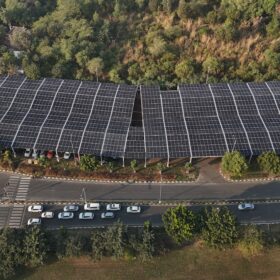Automobile Club de l’Ouest has said that several hydrogen competition prototypes, using fuel cells and hydrogen combustion engines, will compete in a zero-emission competition on June 15 in Le Mans, France. “The participants in this zero CO2 emission driving will be officially revealed in the coming weeks,” said the French automotive association.
Ferrari has filed a patent application for a car with an internal combustion engine powered by hydrogen. The abstract describes a vehicle equipped with two front wheels and two rear drive wheels, powered by a hydrogen-fueled internal combustion engine. It features multiple cylinders with pistons sliding inside, a drive shaft connected to the pistons, and is longitudinally positioned centrally or at the rear. It also includes a transmission system linking the engine’s drive shaft to the rear drive wheels, along with two tanks located adjacent to the engine block on opposite sides.
Stahl-Holding-Saar (SHS) has launched a closed tender process to procure up to 50,000 tons of locally produced green hydrogen for its Dillinger and Saarstahl plants in Saarland, Germany. “As a steel industry, we are sending out a clear signal and creating a secure framework for the development of the local hydrogen economy,” said Jonathan Weber, chief transformation officer at SHS. “We want to offer our customers the first CO2-reduced steel from Saarland from 2027-28.” The plants will produce up to 3.5 million tons of green steel per year from 2027-28.
The Japanese government plans to support the development of low-carbon aviation solutions, including hydrogen-combustion engines, reports Nikkei. Kazuchika Iwata, Japan’s economic vice-minister, said on X (formerly Twitter) that the initiative includes a robust public-private collaboration. The public and private sectors aim to invest JPY 5 trillion ($33 billion) to debut the aviation solutions by around 2035.
This content is protected by copyright and may not be reused. If you want to cooperate with us and would like to reuse some of our content, please contact: editors@pv-magazine.com.








Shell has already closed its hydrogen filling stations in the UK, so it is logical that this could happen in Europe. The problem is a lack of demand for fuel cell grade hydrogen filling stations due to the very high price because the hydrogen is usually produced by an electrolyser powered by expensive grid electricity which in turn is set by the twice daily spot price of gas, an outdated formula when most electricity was produced by gas fired power stations. While this could be changed, it is part of the trans-European electricity supply chain linked to the cost of gas and difficult to unravel. The immediate solution is to power the electrolysers from locally produced “green” electricity. Blue hydrogen produced from fossil methane when 85% of the resulting emission of carbon dioxide is a potential short term source, but has yet to be started commercially. The demise of hydrogen filling stations is regrettable as this will slow down the conversion of heavy vehicles to hydrogen power when the world only has 26 years to meet the 2050 tipping point that is estimated that world net emission of fossil carbon must stop to avoid an anthropogenic extinction event.